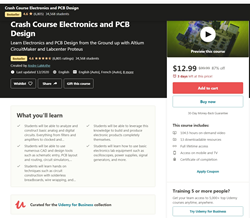
“Crash Course Electronics and PCB Design” with over 34,000 students.
Graduates have went on to build countless products.
AUSTIN, Texas (PRWEB)
January 05, 2021
Crash Course Electronics and PCB Design was designed to educate students from mystery to mastery in Electronics and PCB Design. This massive course was custom made for those interested in learning electronics from the ground up that wish to leverage that knowledge to build actual printed circuit boards (PCBs) and products.
There is no other course like this in existence that has the depth and breadth of Crash Course Electronics. The course starts with atomic physics and the electron; before long students are learning Ohm’s Law, circuit analysis, AC, DC, complex impedance, RC and RL circuits, filters, amplifiers, transistors, FETs, analog and digital theory — too much to list here!
But, unlike other courses that are highly technical and math based. Crash Course Electronics was designed to be taken as a journey with the instructor. Each lecture building on the last, each new concept like a new puzzle approached in many different ways. The most complex topics and mathematical concepts are distilled down into understandable lectures and are a lot of fun as well. Each lecture is given as if the instructor and student are both learning for the first time and makes no assumptions about your background.
As students progress through the lectures, expect to see every circuit and idea worked out on the black board, virtually simulated (with Labcenter Proteus), and built by hand right on camera in real-time 1080P with HDR video and noiseless audio. Not only will students learn all the theory and practical aspects of Electrical Engineering, but Computer Scientist and Electrical Engineer Andre LaMothe’s 35+ years of experience with electronics is available to students with countless real-world tips and tricks that will take hobbyists to a deep understanding of the subject matter.
Once students have all the basic electronic theory under their belts, the course pivots to product development mode and PCB design and not one, not two, but three complete products (including a working Arduino) are developed. Lectures cover the design, motivation, looking up parts, background information, and then design the circuits together like colleagues, lay them out in Altium CircuitMaker, route them, verify and produce manufacturing files.
Finally, students will learn how to take those files and send them to a number of online manufactures and get them ready for production.
Students interested in learning Electronics or PCB Design, or simply want a refresher course then head on over to Udemy and check out “Crash Course Electronics and PCB Design” with over 145 lectures, and 100+ hours of video.
Find out more here.
Share article on social media or email:
